This special dessert, called Brazo de Reina, is a wonderful fusion dessert inspired by both Europe and South America. A thin sponge cake is spread with dulce de leche filling and then rolled into a spiral and topped with coconut. Keep reading for instructions and tips about how to make this yummy and impressive dessert!
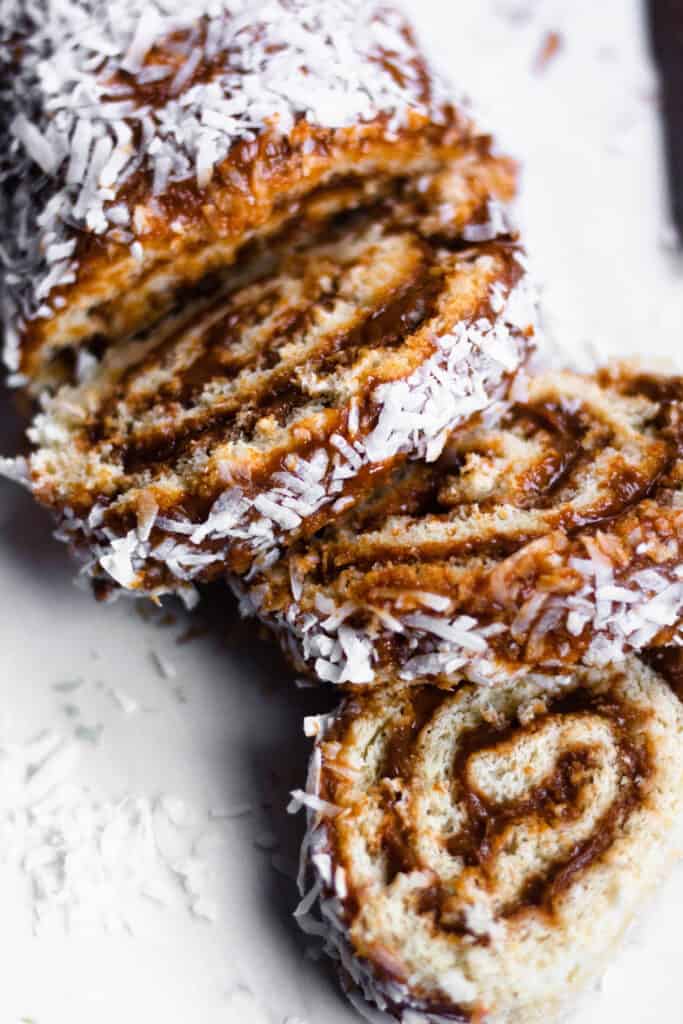
“Hello Reader! I try my hardest to research recipes as best as I can before posting to ensure I am representing each culture correctly. If this recipe is from your country and I have made a mistake or you have suggestions for how to make it more authentic, I would love to hear! Please leave a comment below letting me know what should be different, and I will rework the recipe. It is always my intention to pay homage and respect to each cultural dish that I cook. Thanks for reading!”
What is Brazo de Reina?
If my Spanish minor serves me correctly, I thiiiink that “Brazo de Reina” directly translates to “arm of the queen”. Someone that speaks better Spanish than me please correct me if I’m wrong, here.
Brazo de Reina is a thin sponge cake which is then spread with dulce de leche filling. Once you bake and fill the cake, roll it up tightly into a spiral and then cut into pieces from there. The slices then show the spiral interior of the cake, which adds a beautiful detail to this delicious dessert!
Where Does Brazo de Reina Originate?
Oooh this question is a bit harder to answer than you may have originally thought. This recipe for Brazo de Reina obviously comes from Chile, but…. Does it originate from Chile? The short answer here is no.
The longer answer is…
Rolled cakes are common across the world, in the United States, Europe, South America, and more. They go by different names in each of these locations, including Jelly Roll, Cream Roll, Pionono, and Brazo de Reina.
If you take a look at any of these rolled cakes, you will see that the basic concept is the same… a thin sponge cake coated with a delicious filling and rolled into a spiral.
A dessert of the same name is also made in Spain and is filled with Spanish cream, much like a custard. The filling in the Chilean rendition is oftentimes also called arequipe, though we know the product more commonly as dulce de leche.

What Ingredients are in Brazo de Reina?
It’s actually a fairly short list!
Cake flour
Caster sugar (or normal granulated sugar and a blender)
Eggs
Vanilla
Salt
Dulce de leche
Coconut, if desired
Making Caster Sugar at Home
My pantry is overflowing with every kind of flour, oil, vinegar, sugar, and canned food you can think of. That being said, I have to be selective with what I choose to add into my poor cupboard!
Caster sugar can be bought in stores, but it’s so simple to make at home that I never invest in buying it pre-made!
To make caster sugar at home, all you need is white granulated sugar and a blender. Measurements for caster sugar and granulated sugar are the same, so if you need ¾ cup of caster sugar, simply measure ¾ cup of granulated sugar.
Add your sugar into a blender or a food processor and pulse one or two times. Do not over-blend your sugar or it will turn into powdered sugar instead! In the brief moments between when your granulated sugar becomes powdered sugar, it will transform into superfine “caster” sugar.
What Type of Cake is in this Recipe?
This brazo de reina recipe, and most other rolled cakes recipes, are made with sponge cake.

[adthrive-in-post-video-player video-id=”lJsQ2gyD” upload-date=”2021-05-11T14:40:33.000Z” name=”Brazo de Reina ” description=”his special dessert, called Brazo de Reina, is a wonderful fusion dessert inspired by both Europe and South America. A thin sponge cake is spread with dulce de leche filling and then rolled into a spiral and topped with coconut. Keep reading for instructions and tips about how to make this yummy and impressive dessert! ” player-type=”default” override-embed=”default”]
How Do I Make Sponge Cake?
This was the first time that I had ever made a recipe for sponge cake, so it took quite a bit of research to get the recipe right. I’ve learned that sponge cake is not normally made with a leavening agent like baking soda or baking powder.
Every once in a while, baking powder is added to allow the cake to rise, but normally sponge cake is reliant on something different…. Eggs!
In this recipe, egg whites are whipped until they form stiff peaks. Adding these egg whites into the cake batter introduces a leavening agent to the cake, which allows the cake to rise.
How to Roll a Cake Roll
If you’ve ever watched a good episode of The Great British Baking Show, you’ve heard Paul Hollywood discuss the importance of a tight roll on swiss rolls.
Rolling your Brazo de Reina tightly is imperative for a beautiful cake roll! There are a few steps to properly rolling your sponge cake while making this dessert.
Once your cake is baked in the oven, let it sit for 5 minutes and then immediately transfer the cake from your baking pan onto a dish towel. Roll your Swiss roll tightly into the dish towel while still warm.
Allow the cake to rest, rolled in this shape until it cools completely. Then unroll the cake, spread the dulce de leche, and re-roll.
If you let your cake cool completely before trying to roll it, the cake will crack and break. By rolling the sponge cake while it is warm, you effectively give the cake “muscle memory.” The elasticity in the warm cake allows the dessert to roll without breaking. Then, when re-rolling the cooled cake, it will want to assume its previous shape, allowing the cake to roll once again without cracking.

What Fillings Should I Put in My Brazo de Reina?
If you are following tradition, your Brazo de Reina should always be made with dulce de leche filling. However, if dulce de leche isn’t quite your thing, you can fill this cake with almost anything your heart desires: Jelly, cream, custard, lemon curd, or more.
If you choose any of these other fillings, I don’t think you could officially call your cake “brazo de reina”, but you can call it delicious.
How Should I Decorate my Brazo de Reina?
I’ve seen plenty of Brazo de Reina in my time (meaning over the last like… month and a half). Customarily, the cake is sprinkled with a thin layer of powdered sugar.
In the Foreign Fork version of this dessert, I have chosen a different approach. Once my cake is rolled, I spread extra dulce de leche on the top to cover the entire thing. I then sprinkle sweetened, shredded coconut on top of the cake, which sticks to the dulce de leche topping and decorates the entire masterpiece.
I love the extra texture and flavor that the coconut adds to the dessert, and would definitely recommend decorating your rendition of the dessert this way as well!
Did you like this recipe for Brazo de Reina from Chile? If so, make sure to check out the other awesome cake recipes on my blog:
Thanks for reading everyone! Make sure to check back for more yummy recipes from Chile.

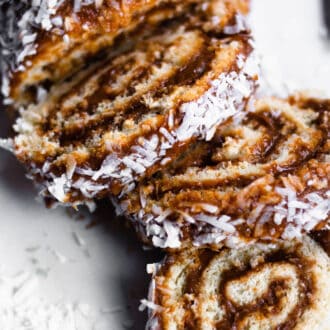
Brazo de Reina
Equipment
Ingredients
- 1 cup Cake flour, sifted
- ¾ cup sugar Superfine sugar, caster sugar + 2 tbsp
- 1½ cups Dulce de leche
- 5 Eggs
- 1.5 tsp Vanilla
- ¼ tsp Salt
Instructions
To Make Caster Sugar:
- Put the sugar in a blender and pulse once or twice until the sugar becomes a bit finer than it was before. Do not blend so long that it becomes powdered sugar.
To Bake the Cake:
- Heat oven to 350 degrees Fahrenheit.
- Crisco a sheet pan, then cut a piece of parchment paper into the shape of the pan and lay it down on the bottom. Crisco the parchment paper and dust with flour.
- Separate egg yolks from egg whites.
- In a large bowl, combine the egg yolks and ¾ cup caster sugar. Beat with an electric mixer until mixture becomes pale and thick, about 3 to 5 minutes. Beat in vanilla and salt.
- In the bowl of a stand mixer (if possible, or with a hand mixer if not) beat the egg whites until soft peaks form. Add 2 tbsp sugar. Beat again until stiff peaks form.
- Fold your yolk mixture into the egg whites with a rubber spatula or wooden spoon. Take care to mix the ingredients, as you don’t want to stir the egg whites too roughly or they will deflate.
- Once the eggs are mixed together, sift the cake flour over the eggs and fold gently to combine.
- Put batter into the prepared pan and place in the oven.
- Bake cake for 15 to 20 minutes, until a toothpick comes out clean when stuck into the middle of the cake.
- Take the cake out of the oven and allow to rest for five minutes. Turn the cake over onto a clean dish towel and remove the parchment paper from the bottom.
- Starting at one short end, roll the cake up with the dish towel, making sure that the towel is rolled into the cake. Allow the cake to rest in this position until completely cooled.
- Unroll the cake and spread 1 cup of dulce de leche across the entire sheet cake. Reroll the cake so that it takes the same shape it took before.
- Place the cake seam-side down. Spread the remaining ½ cup dulce de leche on the top of the cake roll and sprinkle with coconut.
- Cut both ends off of the cake roll to reveal the beautifully spiraled interior. Enjoy!
- Leave a comment on this post letting me know what you thought!





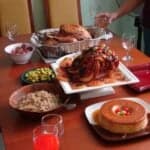

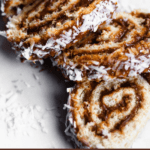
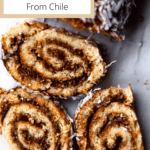
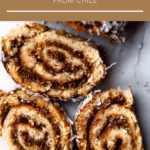
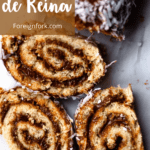
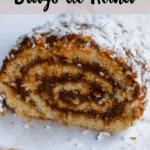
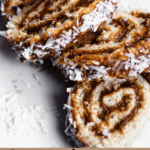
Suiane says
How do you get the cake not to crack? When do you take it out of the oven?
Alexandria Drzazgowski says
Keeping a rolled cake from cracking is super tricky! Remove the cake from the oven when a toothpick comes out clean and then roll it in the towel after just a few minutes. That will allow the cake to get used to the rolled up shape so that when you roll it with filling it doesnt crack!
Natalia says
Love to see some recipes from my country, so excited!! I hope to see more recipes in the future! I would love if u try “leche nevada” or “charquicán”.
The name’s translation its perfect by the way!
P.S: we call dulce de leche: manjar too, but I guess we are the only ones who call it like that xD
The Foreign Fork says
Hi Natalia! I just looked up Leche Nevada and it sounds sooo delicious! I will put it on the list of things to try. I always love hearing from locals, so it makes me so happy that the recipe was done correctly 🙂 Thanks for leaving a comment!